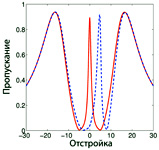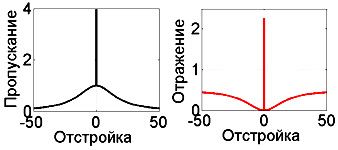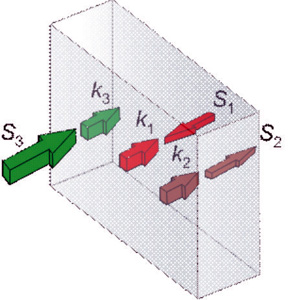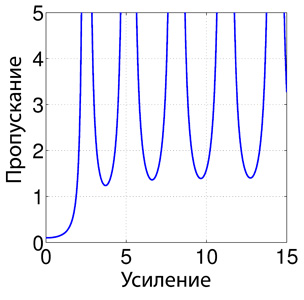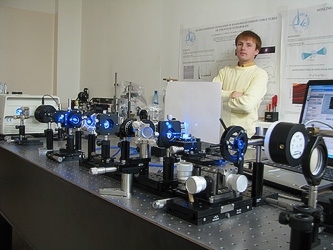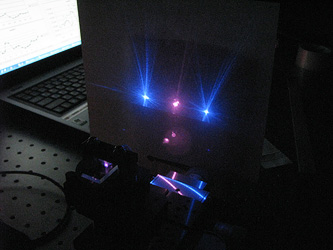Coherent Optics Laboratory
CO: Milestones of History
Main Publications LCO
Scientific Instrumentation Research focus:
1. Linear and nonlinear optical phenomena in atoms, molecules, crystals, micro- and nanostructured materials, including photonic crystals, nonlinear photonic crystals and metamaterials; quantum interference phenomena and control of the optical characteristics of common media, photonic crystals and metamaterials.
2. Plasmon-resonant nanocomposites with optical memory effect, self-organizing componentry for nanoplasmonic light control on the nanoscale.
3. Electron microscopy.
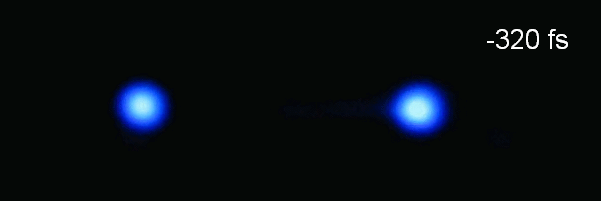
The Movie: RQPM autocorrelator pattern variation with pulse delay.
Main scientific results
1. The spectral properties of photonic crystal (PC) with a defect containing whether medium with Raman amplification or medium with electromagnetically induced transparency (EIT). The transmission and reflection bandwidth of such PC is shown to be much smaller than in common PCs, and both the position of maximum and the bandwidth are optically controllable. The possibility of single-photon all-optical switching in these structures is discovered.
|
|
|
| Transmission spectra of a PC with a EIT defect. (Quant. Electron., 2009). |
Transmission and reflection spectra of a PC with Raman gain medium. Transmission and reflection coefficients are simultaneously greater than unity. (Phys.Rev. A, 2009, JETP, 2010). |
2. The approach is suggested to overcome the losses in negative index refracting metamaterials on the base of three- and four-wave parametric amplification of signal wave that experiences refraction with negative refraction index.
|
|
|
| Parametric amplification at optical frequencies in a metamaterial. S1, S2 and S3 are the Poynting vectors, k1, k2 and k3 are the wavevectors of signal, idler and fundamental waves, correspondingly. |
Right plot: transmission of signal wave as the function of parametric amplification coefficient (Opt. Lett., 2007, 2009; Appl. Phys. Lett., 2008). |
3. The spectral properties of PCs with a liquid crystal (LC) defect are investigated. The dependencies of polarized transmission spectra of PCs with LC defect on the temperature are measured. The peculiarities are studied of the behavior of PC defect modes with the variation of incidence angle for the cases when the light is polarized whether parallel or perpendicular to the LC director axis, while the director axis whether is perpendicular or lies in the incidence plane. The magnetic and electrical field tuning of the transmission spectra of PC with LC defect is investigated.
4. Nonlinear diffraction at the second and third harmonic frequencies is obtained in random nonlinear photonic crystal (NPC) of non-ferroelectric strontium tetraborate (SBO). Random quasi-phase-matching (RQPM) in NPC SBO is investigated experimentally and theoretically. Efficient and widely tunable nonlinear diffraction of femtosecond pulses is obtained. Tunable deep ultraviolet radiation in the range 187-230 nm is obtained via frequency doubling of the second harmonic of femtosecond Ti:sapphire laser in NPC SBO. Red shift of the NPC band structure during the NPC rotation is predicted and experimentally demonstrated. Frequency converters based on random NPC are found to demonstrate super-noncritical spectral and angular properties. Autocorrelators based on random NPC are demonstrated both for RQPM and nonlinear diffraction from virtual beam geometries.
|
|
|
| Experimental set-up for the studies of nonlinear photonic crystals. |
The pattern of nonlinear diffraction from femtosecond laser in a NPC. |
5. The Brownian dynamics method is developed for the description of the nanocolloid structures synthesis, that includes realistic models of binary inter-particle interactions. The method for the local anisotropy control of nanostructured media aggregates is developed, and optical properties of them are investigated. It was shown that local anisotropy of disordered colloid aggregates is the most fundamental characteristic that determines their electrodynamic properties. Fractal aggregates's ability to enhance local electromagnetic fields is only due to their inherent local anisotropy, while the macroscopic characteristics of the aggregates do not render noticeable influence on their electrodynamic interactions with external field. Experimental data confirming this concept are obtained.
Scientific Instrumentation
- Femtosecond laser Spectra Physics Tsunami/MilleniaPro V.
- Supercontinuum generation kit
- Spectrometers Shimadzu UV-3600, Ocean Optics USB4000, USB4000 and Solar MSDD1000.
- Laser elemental analyzer Solar LEA-S500.
- Laser LTI-245-15 (1064 nm).
- Laser DTL-LCS-374QT (355 nm).
- cw lasers ATC53-350 and ATC4000-980-500

